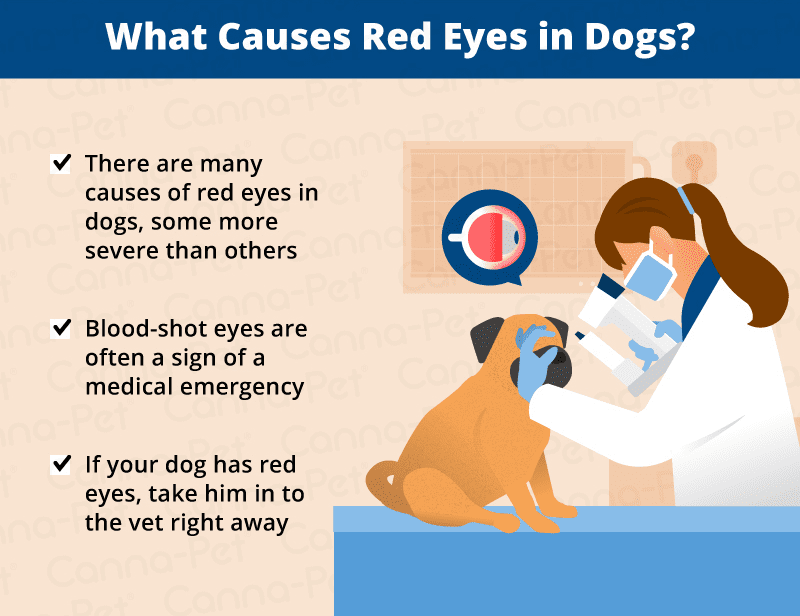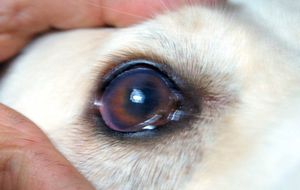
Red eyes in a dog: why redness occurs, diagnosis, treatment and first aid
Often, pet owners at the reception at the veterinarians complain about the redness of the eyes of their pets. Redness of the eye, its inflammation, the appearance of red blood vessels, blood in the eye or on its surface can indicate various diseases in your dog. Therefore, the pet must be taken to an ophthalmologist in order for him to identify the cause of the redness of the eye and make the correct diagnosis.
Causes of Red Eyes in Dogs
Before identifying the cause of why the dog’s eyes turned red, one should evaluate some signs, which are very different in different diseases.
Local (point) redness
It looks like hemorrhages inside or on the surface of the eye. The reason for this may be:
- Hemorrhages under the sclera or conjunctiva due to:
- acute or blunt trauma;
- fungal, parasitic, bacterial, viral infections;
- retinal detachment;
- systemic diseases (diabetes mellitus, arterial hypertension, anemia or problems with blood clotting).
- Displacement or prolapse of the lacrimal gland of the third eyelid.
- The appearance of a tumor inside or on the surface of the eye (may be of viral etiology).
- Neovascularization (ingrowth into the cornea) of the corneal vessels due to damage, ulcers, viral and autoimmune diseases.
diffuse redness
Indicates increased blood supply to the vessels and hyperemia. The reasons for this redness are:
- Conjunctivitiscaused by:
- Allergy to certain environmental components.
- Damage to any foreign object (blunt or sharp, dust, grass seeds).
- Ulcer, erosion of the cornea.
- breed predisposition.
- Hypoplasia of the lacrimal gland of the dog.
- Damage to the cornea by hairs with an ectopic eyelash, trichiasis, districhiasis, entropion.
- Dry eye syndrome, which can be caused due to the removal of the lacrimal gland, autoimmune disease, circulatory disorders, third eyelid adenoma or lacrimal gland hypoplasia.
- Damage to the protein coatand (sclera) arising against the background of:
- Glaucoma, which serves to increase pressure in the eyeball, which causes redness. This is a dangerous disease that causes a change in the internal structure of the eye.
- Autoimmune diseases.
- Uveitis caused by injury, bacteria or viruses. During this disease, the iris and ciliary body become numb. This situation is also typical for dogs with cancer. Anterior uevitis is characterized by swelling of the iris, fluid secretion, and clouding of the cornea.
- neoplasms.
Diagnostics
Having noticed red eyes in a dog, you should think about why this happened, and to identify the cause of this ailment consult a specialist. A veterinarian-ophthalmologist, having examined the animal, can immediately make a diagnosis or conduct an additional examination:

- measure intraocular pressure;
- will carry out the Gauss-Seidel method;
- take a sample for cytology;
- perform a Schirmer tear test;
- make a test by staining the cornea with fluorescein;
- conduct an ultrasound examination.
It is possible that there may be a need for such studies as: MRI of the head, X-ray or CT of the skull.
Treatment
Any treatment depends on the diagnosis based on analyzes and surveys. In some cases, it will be enough for special, prescribed by a doctor, external drops or ointments, tablets or injections to treat a particular pet disease that caused redness. However, sometimes emergency surgery may be required.
First aid
First of all, the owner, who noticed redness in his dog, should put on a special collar on the pet to protect the eyes from aggressive effects on them. After all, usually, inflamed eyes itch, and dogs try to scratch them, which cannot be allowed.
If you suspect that some chemicals have got into your dog’s eyes, you should wash them immediately for thirty minutes with cold running water.
If dust or villi get in, you can use a 1% percent tetracycline ointment and lay it behind the eyelid, rinsing it with running water before that. Well, in this case, Natural Tear drops help, especially for dogs with bulging eyes.
It is not recommended to use anti-inflammatory, anti-allergic or hormone-containing drops without consulting a doctor.
Should remember that self-treatment of a dog is unacceptable, this can lead to sad consequences for your pet. Any eye disease requires consultation with an ophthalmologist or at least a veterinarian.
Of course, it may be that the redness will not have any effect on his health and will pass on its own. But there are cases of loss of vision or even the death of a dog. Therefore, you should play it safe and consult a doctor.





